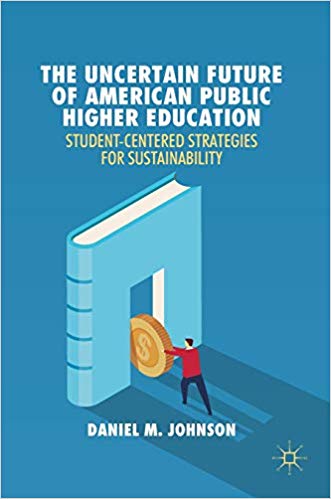
Former University of Toledo President Daniel Johnson’s career, spanning many years and roles at multiple institutions, provides him with an insider’s perspective on higher education. In his introduction, while he acknowledges defending the system for the last 25 years of his career, he also notes that assessing it from the outside gives him a new point of view.
According to Dr. Johnson, paradigms can change and “the paradigm that provides the conceptual, pedagogical, legal, regulatory and financial structures for advanced learning and certification has multiple cracks – some large and some small – all seriously weakening the infrastructure, the very framework, and foundation upon which our public colleges and universities currently rest.” The failure of the higher education paradigm to meet the challenges of today’s education environment brings substantial pressure for change. He maintains that the current manners and modes in which higher education functions are costly and ineffectual and have been for years. Our future success depends on how we prepare our students to find meaningful roles in an economy driven by artificial intelligence, robotics, and an explosion of digitally-based enterprises and industries.
Johnson addresses the issues head-on, beginning with the cost of public higher education. Increasing tuition and higher loan balances for students have caused the public to question the wisdom of pursuing a college degree. The substantial cost increases stem from two causes: (1) the addition to university programs, services, amenities, facilities, technologies, and salaries and (2) the reduction of state support. In fact, from 1975 to 2010, state support decreased from approximately 60% of revenue to 34% of revenue for state institutions. State support in 2017 alone was reported to be $9 billion below that in 2008.
Johnson criticizes the ancient standard of academic credit based on seat time, asserting that it measures neither education nor learning. In other words, time spent in class measures nothing more than time spent in class. New metrics that measure knowledge or competency could be the catalyst for reform and increased public confidence in higher education. He describes several models that measure knowledge — including the European Bologna Process, the Degree Qualifications Profile (DQP), and the Tuning Initiative — all of which stress learning, knowledge, and competencies as the path to a degree.
As applied in American institutions, tenure policies are one of the deepest cracks in the American higher education paradigm. These guarantees reduce flexibility, and market-dependent businesses like most colleges and universities must be able to retain the flexibility to adapt accordingly.
The increasing role of online education will disrupt that of campus-based education. Johnson posits what this means for thousands of campuses and tens of thousands of related buildings. The displacement of campus-based education is happening without an alternative plan for what to do with many of these facilities. These buildings and their associated debt are becoming financial albatrosses for both the universities and states that own them.
One of the most interesting arguments made by Johnson is the role of duplicative programs, citing the unnecessary duplication of state universities just 20 miles apart in Ohio. Adding to this needless cost are those of supporting graduate professional schools just miles apart. The pressure to add these prestige programs blinds trustees to their fiduciary obligations. Having multiple colleges of education, business, and other professional schools serving the same region of a state does not make sense from a fiscal policy perspective. Public universities should reset their academic priorities in order to mitigate the pressures from declining legislative support. Johnson also believes that allowing community colleges to offer four-year degrees (as some states have) is a further recipe for financial disaster with more duplicative programs supported by the state.
In the book’s last chapter, Johnson provides strategies for governors, governing boards, and college presidents to address the changing paradigm in higher education. The die has been cast and for some, it may be too late, for others, better late than never. In recent days, the public higher education sector has witnessed what can happen when a governor and legislature withdraw substantial funding as the governor of Alaska has done for the University of Alaska System. While change for most in higher education comes slowly, my advice would be for many more to read Daniel Johnson’s observations and recommendations.











